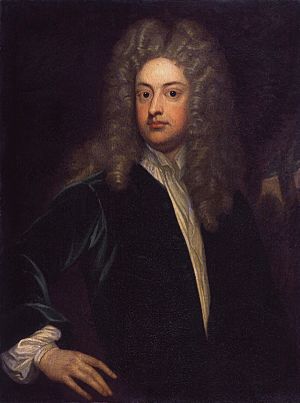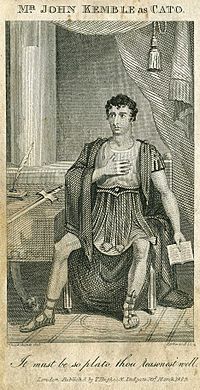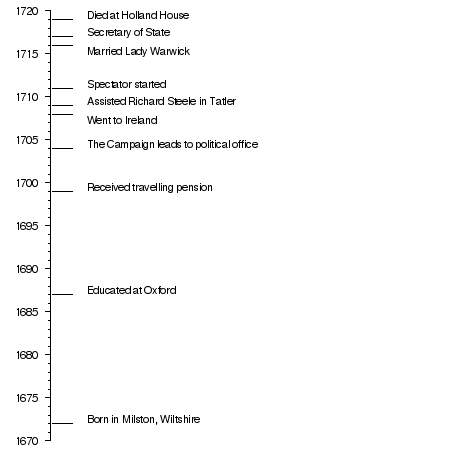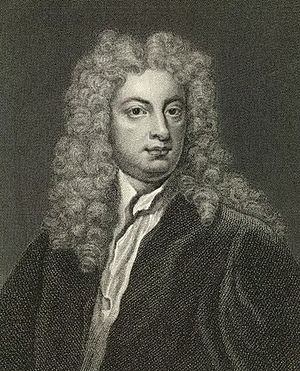Joseph Addison facts for kids
Quick facts for kids
Joseph Addison
|
|
|---|---|

Joseph Addison, the "Kit-cat portrait", circa 1703–1712, by Godfrey Kneller
|
|
| Born | 1 May 1672 Milston, Wiltshire, England
|
| Died | 17 June 1719 (aged 47) Kensington, Middlesex, England
|
| Occupation | Writer and politician |
| Signature | |
Joseph Addison (born May 1, 1672 – died June 17, 1719) was a famous English writer and politician. He wrote essays, poems, and plays. He is often remembered with his good friend Richard Steele. Together, they started a popular magazine called The Spectator. Addison's writing style was clear and simple, which was a new way of writing for his time.
Contents
Who Was Joseph Addison?
Early Life and Education
Joseph Addison was born in Milston, a village in Wiltshire, England. Soon after he was born, his father, Lancelot Addison, became a church leader in Lichfield. So, Joseph's family moved to the area around Lichfield Cathedral. His father was a very educated clergyman.
Joseph went to Charterhouse School in London. This is where he first met his lifelong friend, Richard Steele. Later, he studied at The Queen's College, Oxford and Magdalen College at Oxford University. He was very good at studying old languages like Latin and Greek, especially writing Latin poems.
In 1693, Joseph wrote a poem for a famous poet named John Dryden. A year later, in 1694, he published his first big work, a book about the lives of English poets. He also translated a famous Latin poem called Georgics by Virgil. Important people like John Dryden, Lord Somers, and Charles Montague noticed Addison's talent. They helped him get money to travel around Europe. This trip was meant to help him prepare for a job in diplomacy, which involves dealing with other countries. While traveling, he also kept writing and studying politics.
In 1702, while in Switzerland, Addison learned that King William III had died. This sad news meant he lost his money for traveling because his powerful friends had lost their jobs with the King.
Addison's Political Career
Addison returned to England in late 1703. He didn't have a job for over a year. But then, the Battle of Blenheim happened in 1704. This big battle gave him a new chance to show his skills. The government asked Addison to write a poem to celebrate the victory. He wrote The Campaign, and people liked it so much that he got a job in the government.
In 1705, a political group called the Whigs came into power. Addison became an Under-Secretary of State. This meant he helped a senior government official. He even went on a diplomatic trip to Hanover, Germany, with Lord Halifax. Addison believed that England's strength came from its money, which came from its trade. He thought that free trade and stopping the power of France and Spain were very important for England.
From 1708 to 1709, Addison was a Member of Parliament (MP) for a place called Lostwithiel. Soon after, he became secretary to the new leader of Ireland, Lord Wharton. He also served as an MP in the Irish House of Commons for Cavan Borough from 1709 to 1713. In 1710, he became an MP for Malmesbury in his home county of Wiltshire. He held this seat until he died in 1719.
Starting Famous Magazines
While in Ireland, Addison met Jonathan Swift. He stayed there for a year. Later, he helped create the Kit-Cat Club, a famous social club. He also became good friends with Richard Steele again.
In 1709, Steele started publishing a magazine called the Tatler. Addison quickly became a regular writer for it. In 1711, they started The Spectator. The first issue came out on March 1, 1711. This magazine was published every day and became very popular. It ran until December 20, 1714. For a year in between, they also published another magazine called The Guardian in 1713. Addison's last publication was a political paper called The Freeholder, which he wrote from 1715 to 1716.
Addison's Plays
Addison wrote the words for an opera called Rosamond by Thomas Clayton. However, the opera's first performance in London in 1707 was not successful.
In 1713, Addison's serious play, a tragedy called Cato, was performed. Both the Whigs and the Tories, who were opposing political groups, loved it. After Cato, he wrote a funny play called The Drummer in 1716.
His Famous Play: Cato

Addison wrote his most famous work, Cato, a Tragedy, in 1712. The play is about the last days of a Roman leader named Marcus Porcius Cato Uticensis. It explores big ideas like freedom versus unfair government, and a republic (where people vote for leaders) versus a monarchy (where a king or queen rules). It also looks at how Cato tries to stick to his beliefs even when facing death. The play starts with a special introduction written by Alexander Pope and ends with a closing speech by Samuel Garth.
Cato was a huge success across the British Empire. It became even more popular, especially in America, for many years. Some historians believe it inspired the American Revolution. Many of the Founding Fathers knew this play well. General George Washington even arranged for his soldiers to watch Cato during the tough winter of 1777–78 at Valley Forge. According to one journalist, John J. Miller, Cato might have been the most important piece of literature for the leaders of the American Revolution.
Scholars have found that some famous quotes from the American Revolution might have been inspired by Cato:
- Patrick Henry's famous cry: "Give me liberty or give me death!"
* This might come from Act II, Scene 4 of Cato: "It is not now time to talk of aught/But chains or conquest, liberty or death."
- Nathan Hale's last words: "I regret that I have but one life to give for my country."
* This might be from Act IV, Scene 4: "What a pity it is/That we can die but once to serve our country."
- George Washington's praise for Benedict Arnold in a letter: "It is not in the power of any man to command success; but you have done more—you have deserved it."
* This clearly refers to Act I, Scene 2: "'Tis not in mortals to command success; but we'll do more, Sempronius, we'll deserve it."
In 1789, Edmund Burke quoted the play in a letter. He said that the French people might have to go through many changes before their country settles down. He quoted Addison's Cato (V.i. II): "Through what variety of untried being, through what new scenes and changes must we pass!"
Even though the play is not often performed today, it was very popular in the 1700s. Cato was seen as an example of a good citizen who loved liberty. Two writers, John Trenchard and Thomas Gordon, were inspired by the play. They wrote a series of letters called Cato's Letters (1720–1723) about individual rights, using the name "Cato."
A Famous Hymn
Addison also wrote a well-known church hymn called "The Spacious Firmament on High." He published it in The Spectator in 1712. People still sing it today to tunes like "London (Addison's)" or "Creation" by Joseph Haydn.
Later Life and Death
The last part of Addison's life had some challenges. In 1716, he married Charlotte, the Dowager Countess of Warwick. He had worked as a tutor for her son before. After marrying, he lived at Bilton Hall in Warwickshire.
His political career continued, and he became Secretary of State for the Southern Department from 1717 to 1718. However, his political newspaper, The Freeholder, received a lot of criticism. His wife was said to be proud and bossy, and his stepson was not friendly. Addison was also very shy in public, which made him less effective as a Member of Parliament. He eventually had a disagreement with his friend Steele over a new law.
In 1718, Addison had to leave his job as Secretary of State because he was very sick. But he remained an MP until he died at Holland House, London, on June 17, 1719, at the age of 47. He was buried in Westminster Abbey, a very famous church. After he died, a story was told that on his deathbed, Addison asked for his stepson to come and see how a good Christian faces death.
On April 6, 1808, a town in New York was renamed Addison in his honor. A road in West Kensington, London, called Addison Road, was also named after him.
What Joseph Addison is Remembered For
Today, Joseph Addison is mostly remembered for his essays. He started writing essays almost by chance. In April 1709, his childhood friend Richard Steele began the Tatler magazine. Addison wrote 42 essays for the Tatler, while Steele wrote 188. Steele once said about Addison's help, "when I had once called him in, I could not subsist without dependence on him."
The Tatler stopped being published on January 2, 1711. The Spectator began on March 1 of that year. It was published daily and became very popular. It lasted until December 6, 1712. This magazine had a big impact on readers at the time. Addison soon became the main partner, writing 274 out of 635 essays. Steele wrote 236. Addison also helped Steele with The Guardian, which started in 1713.
Addison is also known for the quote, "Reading is to the mind what exercise is to the body." You can find this quote in Issue 147 of the Tatler.
A bishop named Richard Hurd once criticized Addison's easy, conversational writing style. He called it an "Addisonian Termination" because Addison sometimes ended sentences with a preposition. The poet Alexander Pope also made fun of Addison in a poem in 1735, calling him "Atticus" and comparing him to a snake, "willing to wound, and yet afraid to strike."
Addison wrote an essay called Dialogues on Medals. He also wrote a short story called "Adventures of a Shilling" (1710). This story is an early example of a type of story where an object tells its own adventures. He also left a work about Christianity that was not finished, called Of the Christian Religion.
Timeline of Joseph Addison's Life

See also
 In Spanish: Joseph Addison para niños
In Spanish: Joseph Addison para niños



